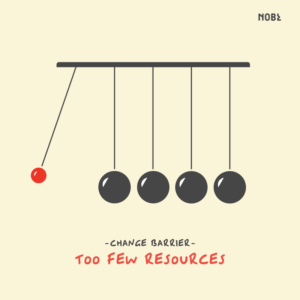After months of hiring shortages and demands for more workers, Big Tech layoffs and hiring freezes are in the headlines. Of course, this isn’t just limited to Big Tech; many leaders in a variety of industries are finding themselves with smaller teams but the same KPI’s.
If you’ve been trying to transform your organization, this couldn’t happen at a worse time. You’re keenly aware that your organization must make widespread, systemic change if it’s going to be prepared for the future, but with fewer resources, how can you make meaningful progress on the promises you’ve made to teams—and yourself?
When teams encounter this barrier to change, we typically see one or more of the following underlying issues:
It’s a scoping problem. The desired end-state is simply too far-reaching for the organization to achieve at the moment. A thorough analysis has identified all the areas that need to improve, and there’s a clear vision for how to change—there’s just not enough time, people, or budget to do it. This is often a particularly painful reality for leaders in a new role to accept, especially if they were just on the verge of rolling out their plan when the situation changed.
It’s a prioritization problem. The organization is still committed to making changes, but teams constantly have to prioritize other work. This often occurs because many leaders simply aren’t aware of everything that teams are being asked to do on a daily basis—and as a result, making change becomes just another task for an overworked employee. It’s an even greater challenge if your organization has developed a “fire drill” culture, where people are rewarded for leaping to solve the newest emergency rather than the important (but not urgent) changes that will better serve the organization in the long run.

NOBL has helped world-famous organizations change collective behavior and business outcomes. Reach out to see how we might be able to help your organization.
It’s a persuasion problem. Sometimes resource constraints aren’t a fait accompli—you can unlock more if you can get attention and convince the right people (or, there are new people in the role who need to be freshly convinced). The problem, of course, is that it’s easy for naysayers to discount the importance of making change, or to fall back on questions like “what’s the ROI?” And sometimes the real challenge is determining who needs to be convinced to get more resources: after all, there’s rarely a line item for “change” in the organization’s yearly budget.
To get back on the path to transformation:
If it’s a scoping problem…
- Don’t make perfect the enemy of the good. High-performing teams in particular are susceptible to this barrier: they’ve used to delivering excellence, and want to make the change truly transformative. Instead, question the ambition or perfection required, and create skateboards and smaller, manageable goals to iterate towards that idealized state.
- Draft coalitions from unexpected or untraditional places. Remember, just because you’re leading the transformation doesn’t mean you have to do it all yourself. In fact, the higher you are within an organization, the less you should be involved in the day-to-day work. Look for rising stars, junior members who are eager to step into new responsibilities, and those who have a good sense of the pulse of the organization’s culture.
If it’s a prioritization problem…
- Ask, “what else is going on within the organization?” Get tactical about the change work required relative to the rest of the organization’s needs. In Adaptive Planning, we divide work into “lights on” (tasks the organization must do to continue to function) and “bets” (the strategic interventions that best position the organization for the future). Understand where time and resources are being spent, and how they’re contributing (or not) to towards goals. Keep in mind that if 95% of the organization’s work is spent keeping the lights on, it’s an indication that something is seriously wrong and requires immediate intervention.
- Incorporate change initiatives into existing work, rather than adding on top of the work. Look for opportunities to try new ways of working in existing structures to keep workload manageable: for instance, introduce check-ins and designate a facilitator in a standing meeting, rather than setting up an additional meeting. For extra credit, give teams time back by not doing things—like canceling an unpopular meeting, or not compiling a report you suspect no one reads—and see if anyone misses them.
- Determine what will happen if the transformation doesn’t happen. It’s easy to compare “spending money on a change initiative vs. saving it,” but this won’t give you an accurate understanding of trade-offs. What’s the larger, long-term impact on the organization? For instance, will continuing on as-is lead to greater levels of burnout and turnover? Will a new product miss a critical deadline? What must your organization sacrifice to achieve its vision? What’s the outcome a year from now?
If it’s a persuasion problem…
- Assess whether this is still the right change. This might seem counterintuitive: surely, you don’t want to be seen questioning the need for change, especially if it was your idea in the first place? But if the market has shifted dramatically, it may have revealed a different or underlying challenge that needs to be addressed first. If others understand how these new problems are directly impacting them, they’ll be more open to your solutions.
- Collect data to build your case. While it may be challenging to measure the ROI of any one particular initiative, literally decades of research have demonstrated that investing in time for team development leads to better performance. Investing in transformation isn’t a case of going against the established wisdom—it is the established wisdom, and all too often, it’s ignored. Make sure you’re keeping your audience in mind: more analytical leaders may be convinced differently than “big picture,” visionary leaders.
- Build a coalition of change-minded individuals. If one person raises an issue, it’s relatively easy to dismiss—but as more people keep repeating the refrain, it becomes harder to dismiss. Seek out other leaders who are frustrated by the status quo, and see if there’s an opportunity to share resources or make a stronger case for change.









The Evolutionary Edge
Every Link Ever from Our Newsletter
Why Self-Organizing is So Hard
Welcome to the Era of the Empowered Employee
The Power of “What If?” and “Why Not?”
An Adaptive Approach to the Strategic Planning Process
Why Culture/Market Fit Is More Important than Product/Market Fit
Group Decision Making Model: How to Make Better Decisions as a Team